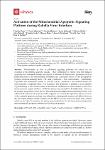Activation of the Mitochondrial Apoptotic Signaling Platform during Rubella Virus Infection
Claus, Claudia
Manssen, Lena
Hübner, Denise
Roßmark, Sarah
Bothe, Viktoria
Petzold, Alice
Große, Claudia
Reins, Mareen
Mankertz, Annette
Frey, Teryl K.
Liebert, Uwe G.
Mitochondria- as well as p53-based signaling pathways are central for the execution of the intrinsic apoptotic cascade. Their contribution to rubella virus (RV)-induced apoptosis was addressed through time-specific evaluation of characteristic parameters such as permeabilization of the mitochondrial membrane and subsequent release of the pro-apoptotic proteins apoptosis-inducing factor (AIF) and cytochrome c from mitochondria. Additionally, expression and localization pattern of p53 and selected members of the multifunctional and stress-inducible cyclophilin family were examined. The application of pifithrin μ as an inhibitor of p53 shuttling to mitochondria reduced RV-induced cell death to an extent similar to that of the broad spectrum caspase inhibitor z-VAD-fmk (benzyloxycarbonyl-V-A-D-(OMe)-fmk). However, RV progeny generation was not altered. This indicates that, despite an increased survival rate of its cellular host, induction of apoptosis neither supports nor restricts RV replication. Moreover, some of the examined apoptotic markers were affected in a strain-specific manner and differed between the cell culture-adapted strains: Therien and the HPV77 vaccine on the one hand, and a clinical isolate on the other. In summary, the results presented indicate that the transcription-independent mitochondrial p53 program contributes to RV-induced apoptosis.
Dateien zu dieser Publikation
Keine Lizenzangabe

